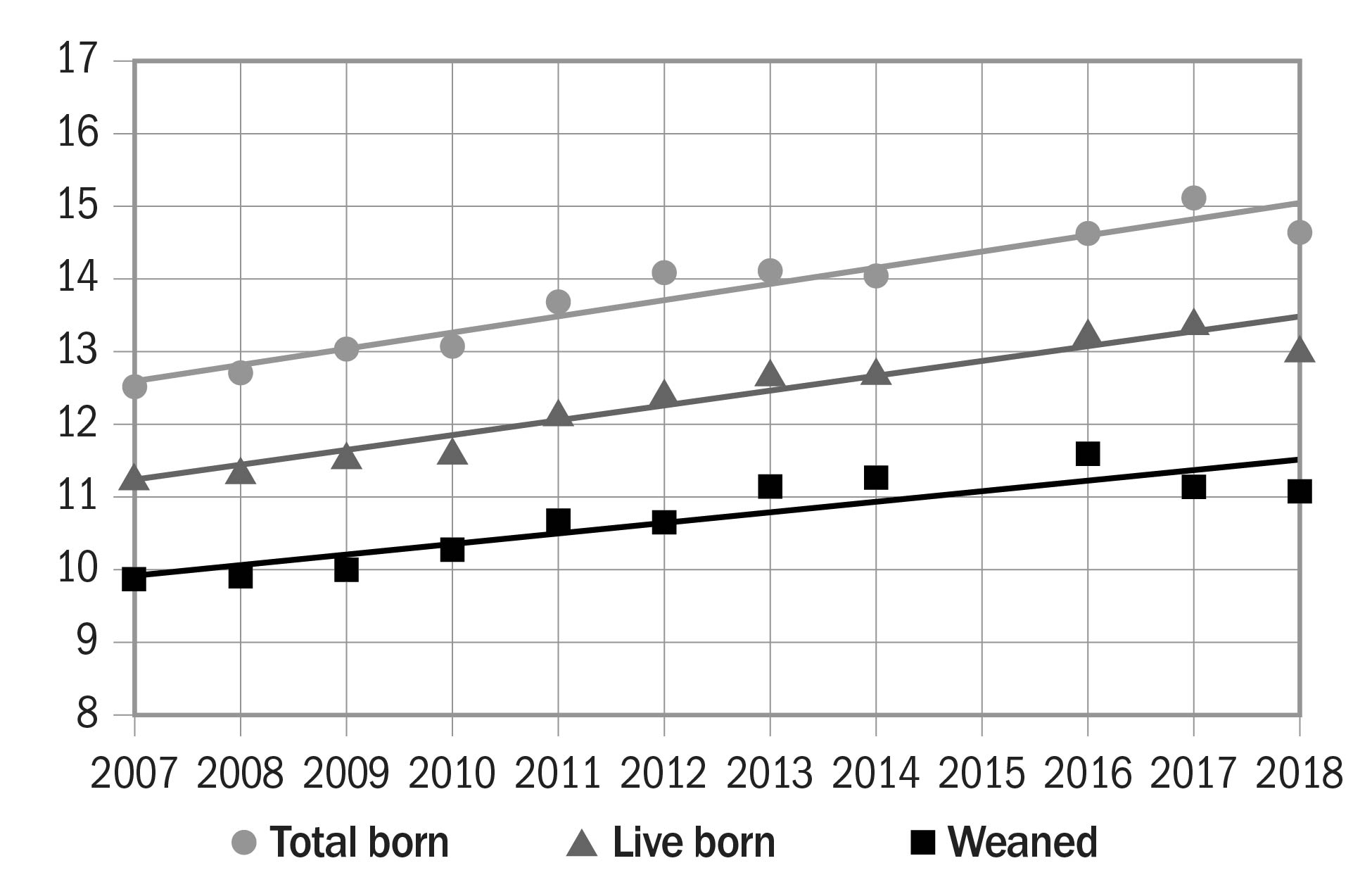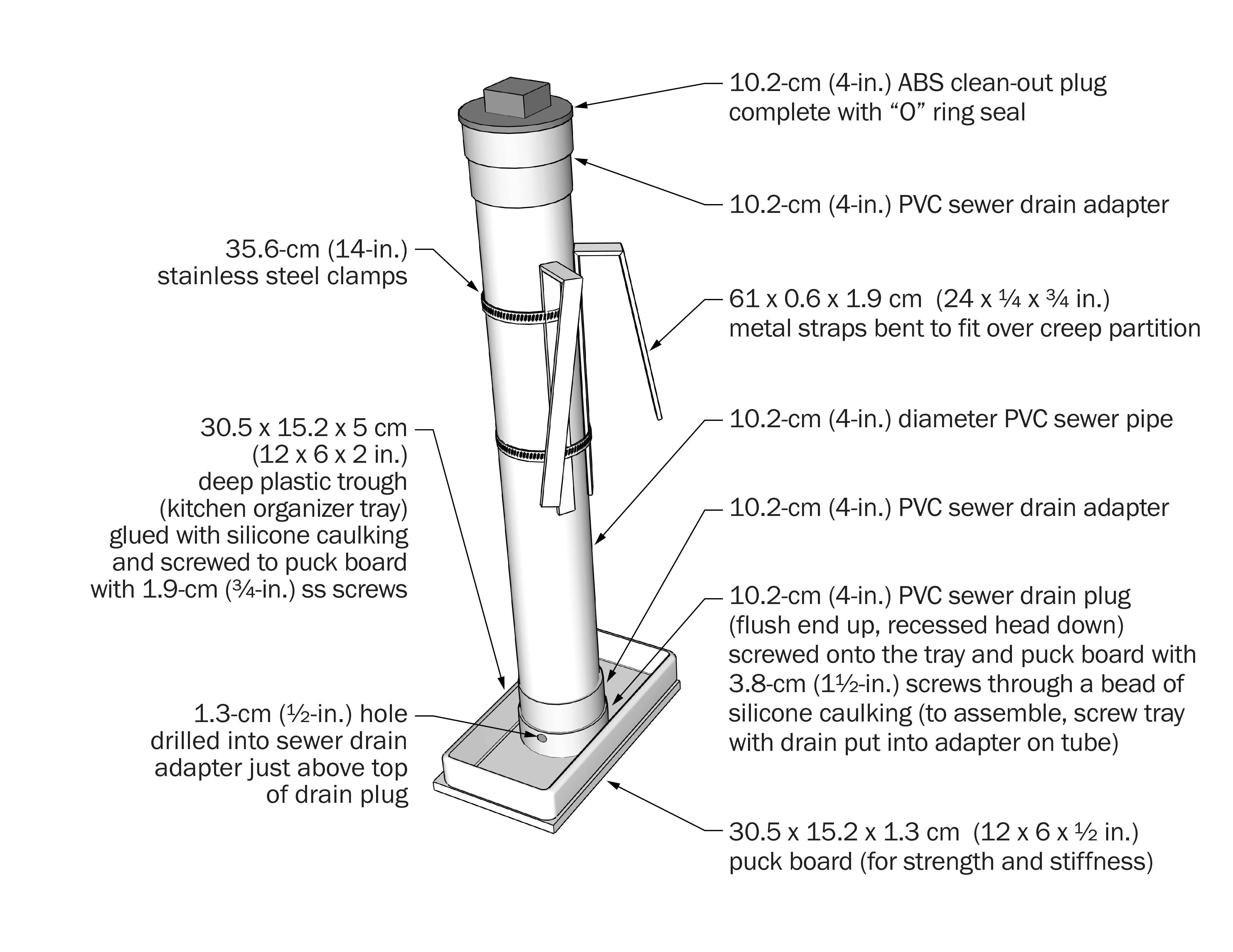Helping high-risk piglets in the farrowing room
Learn about assisting high-risk piglets in the farrowing room, getting them off to a healthy start and reducing pre-weaning mortality rates on farm. This technical information is for commercial pork producers in Ontario.
ISSN 1198-712X, Published February 2020
Introduction
This factsheet will provide guidance on assisting high-risk piglets in the farrowing room, getting them off to a healthy start and reducing pre-weaning mortality rates on farm. Strategies discussed include environmental management, nutritional management (colostrum, milk replacers, gruel feeding, electrolytes, creep feeding) and practices such as cross-fostering, split-suckling and using raised decks.
In today’s hog operations, sows are giving birth to continuously larger litters, and this trend does not seem to be slowing down (Figure 1). Early pig care, especially of high-risk (low-birth-weight) piglets is even more important as litter size steadily increases.
The sow's uterus has a specific capacity. This means that larger litters have the same amount of space as smaller litters, leading to decreased average piglet birth weights as litter size increases
Piglets born at a lower birth weight are automatically disadvantaged and continue to be so throughout development. Higher birth weight piglets grow at faster rates

Figure 1. Average number of piglets born total, born alive and weaned per litter in Canada between 2007 and 2017 (2015 data not available). Source: PigCHAMP Statistics
Pre-weaning mortality (PWM) is a major contributor to total death loss from birth to market, and an important factor driving pigs/sow/year
Environment and management
The farrowing environment should be maintained to help minimize energy losses as much as possible in the first 48 hr of life
A well-designed creep area should be present in the farrowing crate or pen (Figure 2). These are designed to increase energy conservation and protect piglets from crushing. The floor of this area should be solid, and an overhead cover (hover) can help prevent drafts. A heat mat or heat lamp should be used to ensure the creep area is warm enough. The temperature in the creep area should be set so piglets lay in a “pig and a half pile,” a good indicator that the temperature is neither too hot nor too cold

Figure 2. Well-designed creep area with partial solid floor, a hover and a heat lamp. Source: Prairie Swine Centre Inc.
Colostrum
Colostrum is the first milk the sow produces, which is especially rich in antibodies and other immune cells. Unlike in humans, antibodies cannot cross the placental membrane to the piglets during gestation, therefore piglets must consume colostrum after they are born in order to receive this essential immune protection from their mothers. Colostrum will transition to mature milk in the first 24–48 hr of lactation, with immunoglobulins decreasing by approximately half in the first 12 hr
Piglets need to consume at least 100 mL of colostrum. Research has shown that 60% of piglets do not survive if they consume less than 100 mL
Cross-fostering
Some sows have large litters that exceed their number of teats. These sows may not be able to feed their entire litter properly, and some piglets will be at risk of starvation. Other sows produce small litters and would be able to care for more piglets than just their own. Cross-fostering is the act of moving piglets from their birth dam onto an adoptive sow in order to ensure all piglets are fed
There are a few rules to remember when cross-fostering piglets:
- Move the largest piglets in the litter to foster sows. The smaller piglets are more likely to thrive when left with their own sow.
- Try not to move piglets between rooms. Moving piglets between rooms aids in the spread of disease through the barn.
- Move as few piglets as possible. Piglets will do better when left with their own sow, therefore only cross-foster piglets when the sow will not be able to support all her piglets.
- Never add more piglets than there are teats available.
- Only foster piglets out once. Continuously moving litters around increases stress on both piglets and sows.
- If there is a large number of poor doers, foster them onto one sow so there is less competition.
- If smaller piglets must be moved, provide them with a dose of an energy product prior to moving.
Split-suckling
Split-suckling is generally used when cross-fostering is not an option. Split-suckling ensures that smaller piglets get equal access to milk, producing a more uniform litter. The first step in the split-suckling process is to divide the litter into two groups: large piglets and small piglets or strong piglets and weak piglets
Raised decks
There are several commercially available raised decks on the market that act as a home for high-risk piglets
Piglets are typically moved to decks starting on day 3, after colostrum intake, and kept there until weaning
Milk replacers
Supplementing milk in litters where sows are unable to adequately feed all of their piglets can help save some of the higher-risk piglets
Gruel
Gruel is a liquid food composed of a mixture of warm milk replacer, or water, and feed. Gruel feeding aids in reducing starvation and dehydration in piglets and often uses high-quality creep/starter feed. Gruel feeding is very effective at increasing nutrient intake and keeping piglets healthy. However, like feeding milk replacers, it is very labour intensive to ensure the gruel is kept fresh and feeders kept clean. Automated transition feeder systems are available to help reduce the labour requirement, but a standard round creep feeder can work just as well. Gruel feeding can also be carried over into the nursery post-weaning, especially for the lower weight pens of piglets.

Figure 3. Design plans for a homemade milk feeder developed by Dr. Tim Blackwell, OMAFRA.
Electrolytes
Young animals have a higher body weight percentage of water compared to mature animals
Creep feeding
Creep feeding, offering high-quality, highly digestible feed to piglets prior to weaning, is another way to help piglets get off to a good start. Providing creep feed starting one week post-farrowing will help increase weaning weights and piglet survival. See the OMAFRA factsheet Creep feeding to improve piglet performance for information.
Summary
As litter sizes continue to increase, so will the production of small, less competitive piglets. Often these are the smaller-birth-weight piglets, but with the right care immediately after birth, they can become full-value pigs. Remember that piglets have very few energy reserves when born. They need to get dry and suckle shortly after birth in order to thrive. Keep in mind that if a piglet doesn’t suckle right away, and appears cold, it should be given an energy boost before being put under a heat lamp or on a heat pad. A good dose of colostrum is also very important for each and every piglet, as this is how they receive immunity from their mother. Cross-fostering, split-suckling, raised decks and nutritional management strategies can all be used as tools to increase the performance of these piglets. Strong neonatal management in the farrowing room can significantly decrease PWM rates, improving animal welfare, and increase the number of full-value pigs going to market.
References
Baxter, E.M., K.M.D. Rutherford, R.B. D’Eath, G. Arnott, S.P. Turner, P. Sandoe, V.A. Moustsen, F. Thorup, S.A. Edwards, and A.B. Lawrence. 2013. The welfare implications of large litter size in the domestic pig II: Management factors. Animal Welfare. 22: 219–238.
Blackwell, T. 2018. Preventing piglet mortalities: An animal welfare issue we should all endorse. South Western Ontario Pork Conference. Ridgetown, ON.
Cecchinato, A., V. Bonfatti, L. Gallo, P. Carnier. 2008. Survival analysis of preweaning piglet survival in a dry-cured ham-producing crossbred line. Journal of Animal Science. 86: 2486–2495.
Devillers, N., C. Farmer, J. Le Dividich, and A. Prunier. 2007. Variability of colostrum yield and colostrum intake in pigs. Animal. 1(7): 1033–1041.
Devillers, N., J. Le Dividich, and A. Prunier. 2011. Influence of colostrum intake on piglet survival and immunity. Animal. 5(10): 1065–1612.
Eastwood, L. 2018. Creep feeding to improve piglet performance. OMAFRA Factsheet 18-003. ontario.ca/omafra.
Hemsworth, P.H., C.G. Winfield, and P.D. Mullaney. 1975. A study of the development of the teat order in piglets. Applied Animal Ethology. 2: 225–233.
Hurley, W.L. Composition of sow colostrum and milk. 2015. in The gestating and lactating sow. Wageningen Academic Publishers. p. 207.
Klobasa, F., E. Werhahn, and J.E. Butler. 1987. Composition of sow milk during lactation. Journal of Animal Science. 64(5): 1458–1466.
Lewis, N.J., and S. Wamnes. 2006. Use of electrolytes to encourage early feed consumption. Manitoba Pork Council Research January Newsletter.
Loula, T. 2012. Keeping Baby Pigs Alive. 2012 Banff Pork Seminar Proceedings, Canada. pp. 67–73.
Panzardi, A., M.L. Bernardi, A.P. Mellagi, T. Bierhals, F.P. Bortolozzo, and I. Wentz. 2013. Newborn piglet traits associated with survival and growth performance until weaning. Preventative Veterinary Medicine. 110(2): 206–213.
Tenbergen, R., and E. Metzger. 2018. Early Pig Care: Off to the Race. 2018 London Swine Conference Proceedings, Canada. p. 96.
Wiegert, J., and M. Knauer. 2017. Importance of birth weight and colostrum intake on piglet survival and growth. SHMP November 24 Newsletter.
Wolter, B.F., M. Ellis, B.P. Corrigan, and J.M. DeDecker. 2002. The effect of birth weight and feeding of supplemental milk replacer to piglets during lactation on pre weaning and post weaning growth performance and carcass characteristics. Journal of Animal Science. 80: 301–308.
This factsheet was authored by Laura Eastwood, Swine Specialist, OMAFRA, Stratford, and Jaydee Smith, Swine Specialist, OMAFRA, Ridgetown.
Footnotes
- footnote[1] Back to paragraph Wiegert, J., and M. Knauer. 2017. Importance of birth weight and colostrum intake on piglet survival and growth. SHMP November 24 Newsletter.
- footnote[2] Back to paragraph Devillers, N., C. Farmer, J. Le Dividich, and A. Prunier. 2007. Variability of colostrum yield and colostrum intake in pigs. Animal. 1(7): 1033–1041.
- footnote[3] Back to paragraph Loula, T. 2012. Keeping Baby Pigs Alive. 2012 Banff Pork Seminar Proceedings, Canada. pp. 67–73.
- footnote[4] Back to paragraph Blackwell, T. 2018. Preventing piglet mortalities: An animal welfare issue we should all endorse. South Western Ontario Pork Conference. Ridgetown, ON.
- footnote[5] Back to paragraph Panzardi, A., M.L. Bernardi, A.P. Mellagi, T. Bierhals, F.P. Bortolozzo, and I. Wentz. 2013. Newborn piglet traits associated with survival and growth performance until weaning. Preventative Veterinary Medicine. 110(2): 206–213.
- footnote[6] Back to paragraph Tenbergen, R., and E. Metzger. 2018. Early Pig Care: Off to the Race. 2018 London Swine Conference Proceedings, Canada. p. 96.
- footnote[7] Back to paragraph Hurley, W.L. Composition of sow colostrum and milk. 2015. in The gestating and lactating sow. Wageningen Academic Publishers. p. 207.
- footnote[8] Back to paragraph Klobasa, F., E. Werhahn, and J.E. Butler. 1987. Composition of sow milk during lactation. Journal of Animal Science. 64(5): 1458–1466.
- footnote[9] Back to paragraph Cecchinato, A., V. Bonfatti, L. Gallo, P. Carnier. 2008. Survival analysis of preweaning piglet survival in a dry-cured ham-producing crossbred line. Journal of Animal Science. 86: 2486–2495.
- footnote[10] Back to paragraph Baxter, E.M., K.M.D. Rutherford, R.B. D’Eath, G. Arnott, S.P. Turner, P. Sandoe, V.A. Moustsen, F. Thorup, S.A. Edwards, and A.B. Lawrence. 2013. The welfare implications of large litter size in the domestic pig II: Management factors. Animal Welfare. 22: 219–238.
- footnote[11] Back to paragraph Hemsworth, P.H., C.G. Winfield, and P.D. Mullaney. 1975. A study of the development of the teat order in piglets. Applied Animal Ethology. 2: 225–233.
- footnote[12] Back to paragraph Wolter, B.F., M. Ellis, B.P. Corrigan, and J.M. DeDecker. 2002. The effect of birth weight and feeding of supplemental milk replacer to piglets during lactation on pre weaning and post weaning growth performance and carcass characteristics. Journal of Animal Science. 80: 301–308.
- footnote[13] Back to paragraph Lewis, N.J., and S. Wamnes. 2006. Use of electrolytes to encourage early feed consumption. Manitoba Pork Council Research January Newsletter.